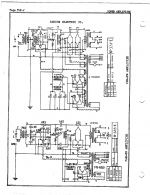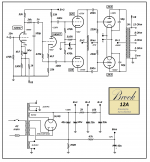A friend in Texas, "David" just finished a project I had asked for help with last year. A Parallel 300B PP amplifier, rated for 40 watts. The Amp was built with two amplifiers in mind, Namely the Samson PAM-29 and the Brooks 12A as the main references but with a few tweaks. I wanted the ability to have a transformer coupled circuit on board with a tube driver so you could switch back and forth. 7N7 Loctals were chosen as the drivers because of literature from the UTC engineers who preferred them over 6SN7.
Another point to make. The four octal sockets could be used for Beam Power tubes yes. But I knew that Emission Labs 300B-XLS Data sheet. made a version of the 300B tube with a center tapped heater. This "Special" 300B required an Octal socket. Emission Labs make some absolutely beautiful tubes. But they're a bit out of my budget. Especially needing a quad for just one channel.
Links to David's youtube videos
YouTube
YouTube
YouTube
Another point to make. The four octal sockets could be used for Beam Power tubes yes. But I knew that Emission Labs 300B-XLS Data sheet. made a version of the 300B tube with a center tapped heater. This "Special" 300B required an Octal socket. Emission Labs make some absolutely beautiful tubes. But they're a bit out of my budget. Especially needing a quad for just one channel.
Links to David's youtube videos
YouTube
YouTube
YouTube
Last edited:
Very Nice. Why just one (monophonic) ?
Limited parts. I would like to build a second once some other iron is found.
Here are the Brook 12A and PAM 29
One thing I've never been able to reconcile is that the Audio choke in the PAM29 circuit is on the Output tube grid side.
On the Brook 12A the audio choke is on the driver tube plate side.
Thoughts?
One thing I've never been able to reconcile is that the Audio choke in the PAM29 circuit is on the Output tube grid side.
On the Brook 12A the audio choke is on the driver tube plate side.
Thoughts?
Attachments
Last edited:
Here are the Brook 12A and PAM 29
One thing I've never been able to reconcile is that the Audio choke in the PAM29 circuit is on the Output tube grid side.
On the Brook 12A the audio choke is on the driver tube plate side.
Thoughts?
The grid choke in theory would cause less bias shift (and so less distortion) when grid current kicks in. The anode choke allows you to get more headroom because you can have the same nominal plate load without the voltage drop of a resistor. However none of these chokes are cheap if their quality has to be good. So why don't get the best of both and simply use a decent interstage transformer? The Brook amplifier comes from an era when the typical bandwidth of interstage transformers was typically 100-10000 Hz! That's why the choke was a better option. A Lundahl LL1635 is not much expensive and has more than enough headroom for a 300B amp.
Same thing for the 300B's.
Don't know if you have different options respect to me but Sophia E., if you buy directly from them grade A tubes, are expensive. They have the cheaper option with punched plate (that's no mesh by any means) at $425 a pair but these cannot take more than 26W for acceptable life service. For good life better to stay within 22-24W. The other options range from 600 to 1200 a pair! They are obviously made by Full Music.... Full Music made and branded aren't cheap either. Those sold by generic sellers who give no guarantee on the quality are 99% grade B weaker tubes. Not worth, IMHO.Another point to make. The four octal sockets could be used for Beam Power tubes yes. But I knew that Emission Labs 300B-XLS Data sheet. made a version of the 300B tube with a center tapped heater. This "Special" 300B required an Octal socket. Emission Labs make some absolutely beautiful tubes. But they're a bit out of my budget. Especially needing a quad for just one channel.
EML XLS is rated 55W and at normal 300B bias point will last at least twice...possibly 3-4x respect to weaker Chinese types. In case don't waste money on the V4 version. Best performance comes with DC filament supply where the centre tap is useless.
If you really want to get good 300Bs and save money I would buy the JJ from a trusted seller. Even better the 2A3-40 because of the 2.5V filament.
Last edited:
Grid chokes can have interleaved E's and I's. There is no DC present.
If you do not balance the two plate currents in a plate choke, it either has to have more laminations, or have an air gap (and more turns, or else it will have less inductance). Otherwise it will saturate too early. More turns might mean poorer high frequency response.
If you do not balance the two plate currents in a plate choke, it either has to have more laminations, or have an air gap (and more turns, or else it will have less inductance). Otherwise it will saturate too early. More turns might mean poorer high frequency response.
azazello,
If you like SE 300B better than PP 300B or PPP 300B, then why not try something like this:
Parallel SE 300B.
To make it work properly, you need to take care of a few details:
A driver that can drive the miller capacitance of two 300Bs.
An output transformer with two times the laminations, two times the current capability, and 1/2 the primary impedance.
And . . .
Either individual filament supplies and individual self bias resistors with individual bypass caps,
OR
Individual fixed adjustable bias for each 300B, and with two coupling caps to keep the DC grid voltages separate for each 300B.
You might find that the sound is the same as a single 300B; but with twice the power at the same distortion level, and with the same damping factor as the single 300B.
If you like SE 300B better than PP 300B or PPP 300B, then why not try something like this:
Parallel SE 300B.
To make it work properly, you need to take care of a few details:
A driver that can drive the miller capacitance of two 300Bs.
An output transformer with two times the laminations, two times the current capability, and 1/2 the primary impedance.
And . . .
Either individual filament supplies and individual self bias resistors with individual bypass caps,
OR
Individual fixed adjustable bias for each 300B, and with two coupling caps to keep the DC grid voltages separate for each 300B.
You might find that the sound is the same as a single 300B; but with twice the power at the same distortion level, and with the same damping factor as the single 300B.
45,
Some DC push pull chokes may not have a DC imbalance rating.
Yes, there are some push pull chokes, and some push pull transformers that do have actual and intended air gaps.
But I think that often the difference between AC push pull chokes, and DC push pull chokes is the presence of an intended air gap.
"All generalizations have exceptions".
Some DC push pull chokes may not have a DC imbalance rating.
Yes, there are some push pull chokes, and some push pull transformers that do have actual and intended air gaps.
But I think that often the difference between AC push pull chokes, and DC push pull chokes is the presence of an intended air gap.
"All generalizations have exceptions".
1. I believe that putting all the E's together, and putting all I's together, and then butt joining the two groups is one thing.
2. I believe this is another thing:
Completely overlaying: E butt to I, then I butt to E, E butt to I, then I butt to E, . . .
Then with them stacked together, one east west, the next west east, the next east west, the next west east . . .
Seems like there is probably 3 to 10 times the area of metal to metal versus number 1. above.
Maybe the amount of area has nothing to do with it.
Is there a physics major in the house?
2. I believe this is another thing:
Completely overlaying: E butt to I, then I butt to E, E butt to I, then I butt to E, . . .
Then with them stacked together, one east west, the next west east, the next east west, the next west east . . .
Seems like there is probably 3 to 10 times the area of metal to metal versus number 1. above.
Maybe the amount of area has nothing to do with it.
Is there a physics major in the house?
Last edited:
TonyTecson,
Interesting. Is that E's overlapped, or all E's lined up.
I had a high current choke intended for filtering noisy 12V car power. It was intended to be used to power a radio. It had a very large wire gauge.
I wanted less inductance to use it as a speaker crossover coil. I removed all the I's and that worked well.
Interesting. Is that E's overlapped, or all E's lined up.
I had a high current choke intended for filtering noisy 12V car power. It was intended to be used to power a radio. It had a very large wire gauge.
I wanted less inductance to use it as a speaker crossover coil. I removed all the I's and that worked well.
You might find that the sound is the same as a single 300B; but with twice the power
Inclined to think he tried it and didn't like it.
- Status
- This old topic is closed. If you want to reopen this topic, contact a moderator using the "Report Post" button.
- Home
- Amplifiers
- Tubes / Valves
- 300B PP Parallel amplifier

